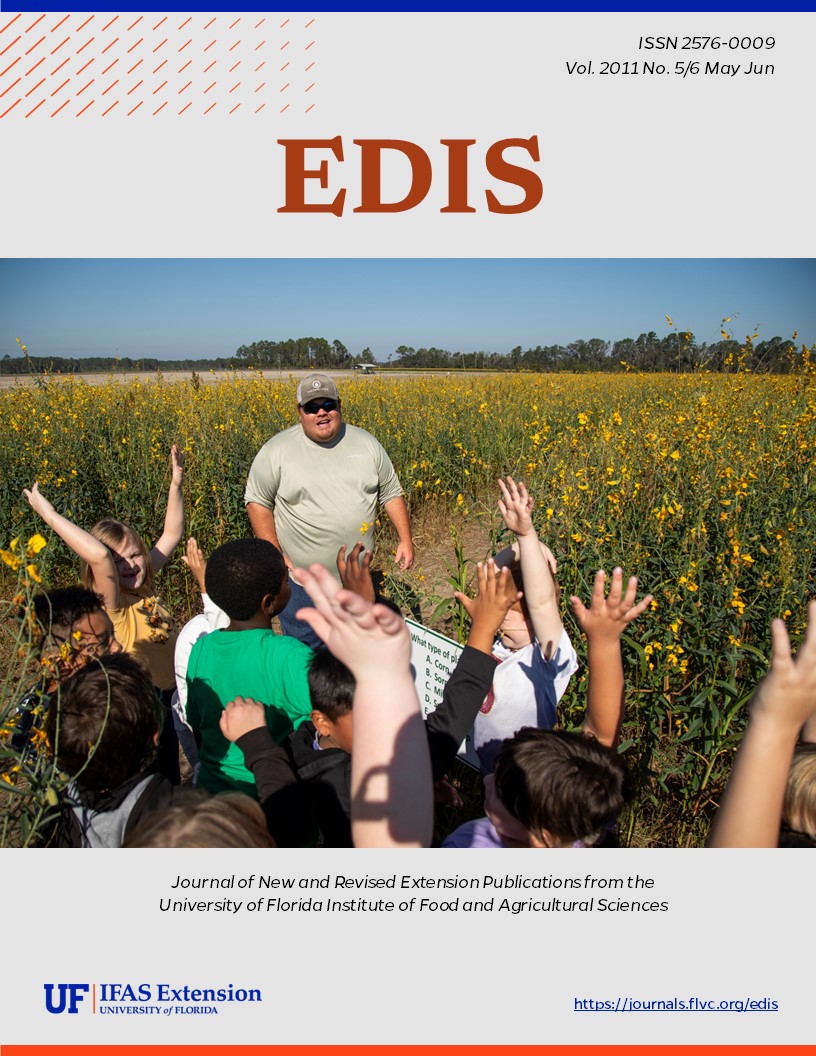Abstract
The horn fly is one of the most economically important pests of cattle worldwide. Just in the United States, hundreds of millions of dollars in losses are attributed to the horn fly annually, while additional millions are spent annually on insecticides to reduce horn fly numbers. Learn more about this pernicious obligate blood-feeding ectoparasite in this 7-page fact sheet, written by Dan Fitzpatrick and Phillip E. Kaufman, and published by the UF Department of Entomology and Nematology, April 2011.
References
Baldwin JL, Foil LD, Hogsette JA. (May 2005). Important fly pests of Louisiana beef cattle. LSUAgCenter. http://www.lsuagcenter.com/NR/rdonlyres/AF963495-28CE-4190-BB5D-C675C27BFA78/8364/pub2617flypests4.pdf (28 March 2011).
Bruce WG. 1938. A practical trap for the control of horn flies on cattle. Journal of the Kansas Entomological Society 11: 88-93.
Byford RL, Craig ME, Crosby BL. 1992. A review of ectoparasites and their effect on cattle production. Journal of Animal Science 70: 597-602. https://doi.org/10.2527/1992.702597x
Campbell JB. (June 2006). Horn fly control on cattle. University of Nebraska-Lincoln Extension Publication. http://www.ianrpubs.unl.edu/epublic/live/g1180/build/g1180.pdf (28 March 2011).
Cupp EW, Cupp MS, Ribeiro JMC, Kunz SE. 1998. Bloodfeeding strategy of Haematobia irritans (Diptera: Muscidae). Journal of Medical Entomology 35: 591-595. https://doi.org/10.1093/jmedent/35.4.591
Edwards JF, Wikse SE, Field RW, Hoelscher CC, Herd DB. 2000. Bovine teat atresia associated with horn fly (Haematobia irritans irritans (L))-induced dermatitis, Veterinary Pathology 37: 360-364. https://doi.org/10.1354/vp.37-4-360
Floate KD, Spooner RW, Colwell DD. 2001. Larvicidal activity of endectocides against pest flies in the dung of treated cattle. Medical and Veterinary Entomology 15: 117-120. https://doi.org/10.1046/j.1365-2915.2001.00269.x
Foil LD, Hogsette JA. 1994. Biology and control of tabanids, stable flies and horn flies. Revue Scientifique et Technique 13: 1125-1158. https://doi.org/10.20506/rst.13.4.821
Geden CJ, Moon RD, Butler JF. 2006. Host ranges of six solitary filth fly parasitoids (Hymenoptera: Pteromalidae, Chalcididae) from Florida, Eurasia, Morocco, and Brazil. Environmental Entomology 35: 405-412. https://doi.org/10.1603/0046-225X-35.2.405
Gillespie BE, Owens WE, Nickerson SC, Oliver SP. 1999. Deoxyribonucleic acid fingerprinting of Staphylococcus aureus from heifer mammary secretions and from horn flies. Journal of Dairy Science 82: 1581-1585. https://doi.org/10.3168/jds.S0022-0302(99)75386-5
Harris RL, Miller JA, Frazar ED. 1974. Horn flies and stable flies: feeding activity. Annals of the Entomological Society of America 67: 891-894. https://doi.org/10.1093/aesa/67.6.891
Haufe WO. 1982. Growth of range cattle protected from horn flies Haematobia irritans by ear tags impregnated with fenvalerate. Canadian Journal of Animal Science 62: 567-573. https://doi.org/10.4141/cjas82-066
Hibler CP. 1966. Development of Stephanofilaria stilesi in horn fly. Journal of Parasitology 52: 890-898. https://doi.org/10.2307/3276527
Hogsette JA, Prichard DL, Ruff JP. 1991. Economic effects of horn fly (Diptera: Muscidae) populations on beef cattle exposed to three pesticide treatment regimes. Journal of Economic Entomology 84: 1270-1274. https://doi.org/10.1093/jee/84.4.1270
Hu GY, Frank JH. 1996. Effect of the red imported fire ant (Hymenoptera: Formicidae) on dung-inhabiting arthropods in Florida. Environmental Entomology 25: 1290-1296. https://doi.org/10.1093/ee/25.6.1290
Kerlin RL, Allingham PG. 1992. Acquired immune response of cattle exposed to buffalo fly (Haematobia irritans exigua). Veterinary Parasitology 43: 115-129. https://doi.org/10.1016/0304-4017(92)90054-D
Koehler, PG, Butler JF, Kaufman PE. (December 2005). Horn flies. EDIS. http://edis.ifas.ufl.edu/ig137 (28 March 2011).
Krafsur ES, Ernst CM. 1986. Phenology of horn fly populations (Diptera: Muscidae) in Iowa, USA. Journal of Medical Entomology 23: 188-195. https://doi.org/10.1093/jmedent/23.2.188
Kuramochi K, Nishijima Y. 1980. Measurement of the meal size of the horn fly, Haematobia irritans (L.) (Diptera: Muscidae), by the use of amaranth. Applied Entomological Zoology 15: 262-269. https://doi.org/10.1303/aez.15.262
Lysyk TJ. 1991. Use of life-history parameters to improve a rearing method for horn fly, Haematobia irritans irritans (L) (Diptera, Muscidae), on bovine hosts. Canadian Entomologist 123: 1199-1207. https://doi.org/10.4039/Ent1231199-6
Lysyk TJ. 1992. Effect of larval rearing temperature and maternal photoperiod on diapause in the horn fly (Diptera, Muscidae). Environmental Entomology 21: 1134-1138. https://doi.org/10.1093/ee/21.5.1134
Lysyk TJ, Colwell DD. 1996. Duration of efficacy of diazinon ear tags and ivermectin pour-on for control of horn fly (Diptera: Muscidae). Journal of Economic Entomology 89: 1513-1520. https://doi.org/10.1093/jee/89.6.1513
Lysyk TJ, Kalischuk-Tymensen LD, Rochon K, Selinger LB. 2010. Activity of Bacillus thuringiensis isolates against immature horn fly and stable fly (Diptera: Muscidae). Journal of Economic Entomology 103: 1019-1029. https://doi.org/10.1603/EC10018
Mendes J, Linhares AX. 1999. Diapause, pupation sites and parasitism of the horn fly, Haematobia irritans, in south-eastern Brazil. Medical and Veterinary Entomology 13: 180-185. https://doi.org/10.1046/j.1365-2915.1999.00155.x
Miller JA, Kunz SE, Oehler DD, Miller RW. 1981. Larvicidal activity of Merck MK-933, an avermectin, against the horn fly, stable fly, face fly, and house fly. Journal of Economic Entomology 74: 608-611. https://doi.org/10.1093/jee/74.5.608
Nickerson SC, Owens WE, Boddie RL. 1995. Mastitis in dairy heifers - initial studies on prevalence and control, Journal of Dairy Science 78: 1607-1618. https://doi.org/10.3168/jds.S0022-0302(95)76785-6
Owens WE, Oliver SP, Gillespie BE, Ray CH, Nickerson SC. 1998. Role of horn flies (Haematobia irritans) in Staphylococcus aureus-induced mastitis in dairy heifers. American Journal of Veterinary Research 59: 1122-1124.
Oyarzún, MP, Quiroz A, Birkett MA. 2008. Insecticide resistance in the horn fly: alternative control strategies. Medical and Veterinary Entomology 22: 188-202. https://doi.org/10.1111/j.1365-2915.2008.00733.x
Pruett JH, Steelman CD, Miller JA, Pound JM, George JE. 2003. Distribution of horn flies on individual cows as a percentage of the total horn fly population. Veterinary Parasitology 116: 251-258. https://doi.org/10.1016/j.vetpar.2003.07.004
Sanson DW, DeRosa AA, Oremus GR, Foil LD. 2003. Effect of horn fly and internal parasite control on growth of beef heifers. Veterinary Parasitology 117: 291-300. https://doi.org/10.1016/j.vetpar.2003.09.005
Schreiber ET, Campbell JB, Kunz SE, Clanton DC, Hudson DB. 1987. Effects of horn fly (Diptera: Muscidae) control on cows and gastrointestinal worm (Nematode: Trichostrongylidae) treatment for calves on cow and calf weight gains. Journal of Economic Entomology 80: 451-454. https://doi.org/10.1093/jee/80.2.451
Summerlin JW, Petersen HD, Harris RL. 1984. Red imported fire ant (Hymenoptera: Formicidae): effects on the horn fly (Diptera: Muscidae) and coprophagous scarabs. Environmental Entomology 13: 1405-1410. https://doi.org/10.1093/ee/13.5.1405
Szalanski, AL, Black WC, Broce AB. 1991. Esterase staining activity in pyrethroid-resistant horn flies (Diptera: Muscidae). Journal of the Kansas Entomological Society 68: 303-312.
Watson DW, Stringham SM, Denning SS, Washburn SP, Poore MH, Meier A. 2002. Managing the horn fly (Diptera: Muscidae) using an electric walk-through fly trap. Journal of Economic Entomology 95: 1113-1118. https://doi.org/10.1093/jee/95.5.1113

